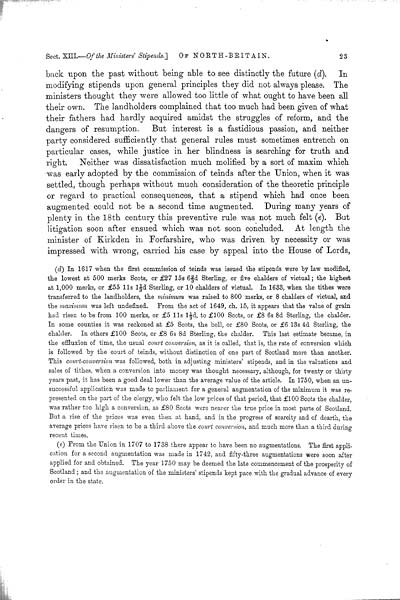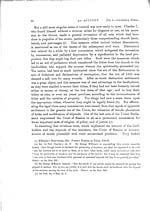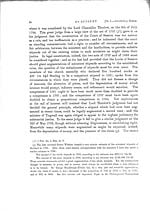Volume 3
(31) Page 23
Download files
Individual page:
Thumbnail gallery: Grid view | List view

23
brick upon the past without being able to see distinctly the future (d). In
modifying stipends upon general principles they did not always please. The
ministers thought they were allowed too little of what ought to have been all
their own. The landholders complained that too much had been given of what
their fathers had hardly acquired amidst the struggles of reform, and the
dangers of resumption. But interest is a fastidious passion, and neither
party considered sufficiently that general rules must sometimes entrench on
particular cases, while justice in her blindness is searching for truth and
right. Neither was dissatisfaction much molified by a sort of maxim which
was early adopted by the commission of teinds after the Union, when it was
settled, though perhaps without much consideration of the theoretic principle
or regard to practical consequences, that a stipend which had once been
augmented could not be a second time augmented. During many years of
plenty in the 18th century this preventive rule was not much felt (e). But
litigation soon after ensued which was not soon concluded. At length the
minister of Kirkden in Forfarshire, who was driven by necessity or was
impressed with wrong, carried his case by appeal into the House of Lords,
(d) In 1617 when the first commission of teinds was issued the stipends were by law modified,
the lowest at 500 merks Scots, or �27 15s 6�d Sterling, or five chalders of victual; the highest
at 1,000 merks, or �55 11s 1d Sterling, or 10 chalders of victual. In 1633, when the tithes were
transferred to the landholders, the minimum was raised to 800 merks, or 8 chalders of victual, and
the maximum was left undefined. From the act of 1649, ch. 15, it appears that the value of grain
had risen to be from 100 merks, or �5 11s l?|d, to �100 Scots, or �8 6s 8d Sterling, the chalder.
In some counties it was reckoned at �5 Scots, the boll, or �80 Scots, or �6 13s 4d Sterling, the
chalder. In others �100 Scots, or �8 6s 8d Sterling, the chalder. This last estimate became, in
the effluxion of time, the usual court conversion, as it is called, that is, the rate of conversion which
is followed by the court of teinds, without distinction of one part of Scotland more than another.
This court-conversion was followed, both in adjusting ministers' stipends, and in the valuations and
sales of tithes, when a conversion into money was thought necessary, although, for twenty or thirty
years past, it has been a good deal lower than the average value of the article. In 1750, when an un-
successful application was made to parliament for a general augmentation of the minimum it was re-
presented on the part of the clergy, who felt the low prices of that period, that �100 Scots the chalder,
was rather too high a conversion, as �80 Scots were nearer the true price in most parts of Scotland.
But a rise of the prices was even then at hand, and in the progress of scarcity and of dearth, the
average prices have risen to be a third above the court conversion, and much more than a third during
recent times.
(e) From the Union in 1707 to 1738 there appear to have been no augmentations. The first appli-
cation for a second augmentation was made in 1742, and fifty-three augmentations were soon after
applied for and obtained. The year 1750 may be deemed the late commencement of the prosperity of
Scotland; and the augmentation of the ministers' stipends kept pace with the gradual advance of every
order in the state.
Set display mode to:
![]() Universal Viewer |
Universal Viewer | ![]() Mirador |
Large image | Transcription
Mirador |
Large image | Transcription
Images and transcriptions on this page, including medium image downloads, may be used under the Creative Commons Attribution 4.0 International Licence unless otherwise stated. ![]()
| Caledonia, or, An account, historical and topographic of North Britain from the most ancient to the present times > Volume 3 > (31) Page 23 |
|---|
| Permanent URL | https://digital.nls.uk/74528136 |
|---|---|
| Description | Vol. III. |
|---|---|
| Attribution and copyright: |
|

